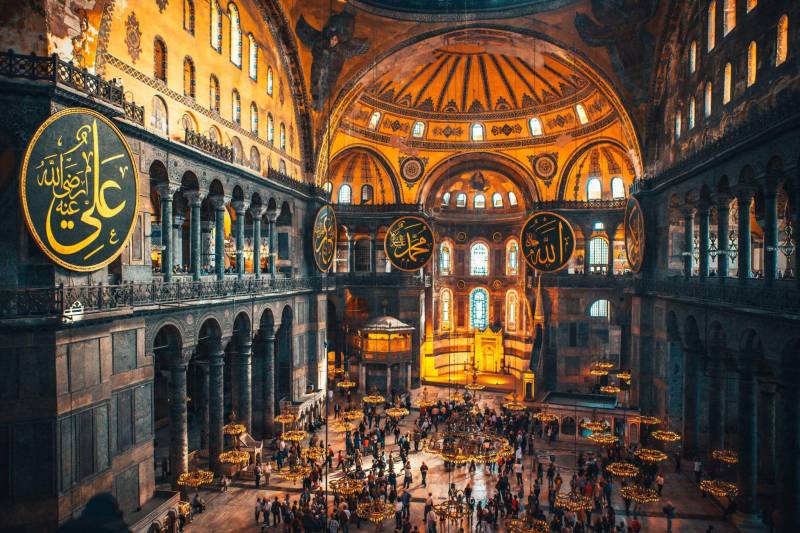Istanbul, historically known as Byzantium and Constantinople, is a city rich in history, culture, and architectural marvels. Among its many distinctive characteristics are the beautiful domes that decorate the city’s skyline. These domes provide witness to the city’s Byzantine heritage and its lasting effect on Istanbul’s architecture. In this article, we will take a historical tour around Istanbul’s Byzantine domes, investigating their significance, building processes, and the impact they have left behind.
The Byzantine Empire, having its capital in Constantinople, lasted a thousand years, from the fourth to the fifteenth centuries. During this time, the empire saw unprecedented development and wealth, leaving a lasting impact on a variety of industries, including architecture. The Byzantines were noted for their unique architectural style, which blended aspects of Roman, Greek, and Eastern influences. The dome is one of the most noticeable characteristics of Byzantine architecture. Inspired by the magnificence of the Roman Pantheon, Byzantine builders developed the skill of dome construction and used it in both religious and secular structures. These domes were a symbol of imperial strength and heavenly connection, as well as an eye-catching architectural element.
- Awe-Inspiring Dome: The Hagia Sophia’s Magnificence: No study of Byzantine domes is complete without addressing the Hagia Sophia. It was originally erected as a Byzantine cathedral in the 6th century and stands as a tribute to the majesty and technical brilliance of Byzantine architecture. The massive dome of the Hagia Sophia, spanning 31 meters in circumference and reaching a height of 55 meters, continues to captivate tourists with its sheer majesty.
Dimensions and Structural Techniques: The dome of the Hagia Sophia was an incredible accomplishment of engineering. Byzantine architects Anthemius of Tralles and Isidore of Miletus used creative structural techniques to sustain the massive dome, employing pendentives and semi-domes to disperse weight and give the appearance of weightlessness. The installation of enormous windows allowed natural light to permeate the inside, creating an ethereal and awe-inspiring ambiance.
- The Chora Museum: A Living Monument to Byzantine Art: Another notable example of a Byzantine dome is the Church of the Holy Savior in Chora, better known as the Chora Museum. It was built in the 11th century and has a sequence of artistically ornamented domes depicting scenes from Christ and the Virgin Mary’s lives. The exquisite mosaics and paintings that cover these domes illustrate the Byzantine Empire’s great aesthetic achievements as well as its devotion to religious imagery.
-Byzantine Art and Religious Iconography:
The domes of the Chora Museum are a witness to Byzantine workmanship and the importance of religious symbolism throughout the empire. They provide a look into the spirituality of Byzantine society as well as the value of visual storytelling in expressing religious themes.
Image Credit: eskaps.
https://eskapas.com/hagia-sophia-an-architectural-marvel/
- Beyond Istanbul, There Are Byzantine Domes: The heritage of Byzantine domes reaches far beyond Istanbul. As the empire grew in size, so did its architectural impact. The domes of Byzantine churches and basilicas extended over the empire’s territory, leaving an unmistakable mark on the cities they decorated. The impact of Byzantine architecture may be observed in the domed constructions that have lasted the test of time in locations like Thessaloniki, Ravenna, and even Venice.
Domes of Note in Thessaloniki, Ravenna, and Venice: Thessaloniki, Ravenna, and Venice are among the cities with outstanding Byzantine domes. Structures such as the Rotunda in Thessaloniki, the Basilica of San Vitale in Ravenna, and St. Mark’s Basilica in Venice demonstrate the impact and adaption of Byzantine architectural components in diverse places.
- Adaptations and transformations: Istanbul’s rich history is marked by important political and cultural developments. Many Byzantine churches were turned into mosques following the collapse of the Byzantine Empire and the advent of the Ottoman Empire. These conversions resulted in architectural changes and the incorporation of Islamic features into existing structures.
- The Rediscovery of Byzantine Heritage: UNESCO has designated the Hagia Sophia as a World Cultural Heritage site, owing to its remarkable history and architecture. There has been a revived interest in conserving and renovating Byzantine structures in Istanbul in recent years. Efforts have been undertaken to preserve the domes and their exquisite embellishments, allowing tourists to witness the magnificence of Byzantine architecture for themselves. Since 1935, the Hagia Sophia has been a museum, and it has remained a popular tourist destination and a symbol of Istanbul’s rich historical and cultural legacy.
-Stunning Domes and Ornate Decorations:
By maintaining Byzantine domes, the splendor of their architectural design and ornamental components may be completely appreciated. Mosaics, frescoes, and exquisite decoration provide insight into the empire’s aesthetic triumphs, as well as views into the cultural and theological importance of the Byzantine world.
-Recognizing Byzantine Architecture as a Cultural Heritage:
The preservation and enjoyment of Byzantine architecture are critical components in embracing Istanbul’s cultural history. By recognizing the historical significance and architectural splendor of Byzantine domes, the city respects its history while also acknowledging the lasting impact of Byzantine culture on its identity.
Conclusion
The Byzantine domes of Istanbul are testaments to the Byzantine Empire’s creativity, artistic brilliance, and architectural achievements. They represent the empire’s grandeur, spiritual dedication, and architectural brilliance, leaving an unforgettable impression on the cultural and historical environment of Istanbul. Contemporary architects and artists are still inspired by the Byzantine domes. Their inventive building techniques, remarkable aesthetics, and eternal beauty continue to serve as a source of inspiration for contemporary architectural design and creative endeavors. Visiting Istanbul allows you to experience firsthand the awe-inspiring grandeur of Byzantine domes. Exploring architectural marvels such as the Hagia Sophia and the Chora Museum helps us to appreciate the majesty of Byzantine architecture, immerse ourselves in history, and obtain a better knowledge of Istanbul’s diverse cultural tapestry.



